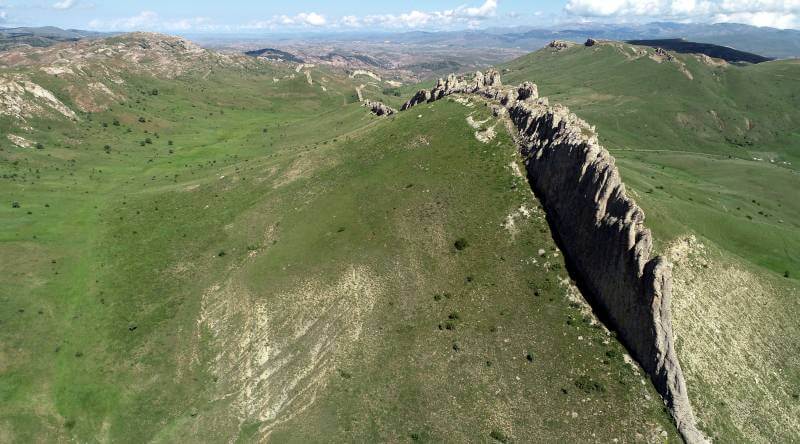A naturally formed wall in the province of Sivas in central Anatolia can become a tourist hotspot.
A natural rock formation in the central Anatolian province of Sivas believed to resemble the Great Wall of China has become a new hope for local tourism.
It is a natural formation of several kilometers located in the village of Boğazören, in the district of İmranlı.
The height of the “wall of Sivas”, which seems to divide the plain on which it is perched, can reach 50 to 60 meters in height depending on the altitude of the terrain on which it stands.
As soon as the measures taken as part of the process of returning to normalcy amid the COVID-19 outbreak were eased, local officials organized a trip to the area to promote the rock formation.
“We want to show this beauty to Turkey and the world,” said district governor Hasan Meşeli.
” It’s original. Gypsum took its shape over the centuries under the effects of rain and winds. It’s natural,” added Meşeli, who served as the tour guide.
Niyami Dağlar, head of the provincial directorate of youth and sports, was one of the participants. “We will walk in nature with the magnificent view of the Great Wall village of Boğazören,” Dağlar said, not hiding his admiration for the natural formation.
More information about Sivas
Sivas is a city of about 293,000 inhabitants (2009), capital of the province of the same name, which is located in the northeast of Cappadocia.
It was founded by the Hittites, but only gained importance much later, under Roman rule, when it was called Sebastea (Sebaste).
In Christian tradition, the Forty Martyrs of Sebaste refers to Roman soldiers who drowned for refusing to renounce their faith.
Under Justinian the city became the capital of the province of Armenia Prima, but it reached its greatest development under the Seljuks in the 12th and 13th centuries.
It experienced a famous siege, which ended in its submission to Tamerlane in 1400, following which all the Christian inhabitants were either exterminated or reduced to slavery.
Sivas has many examples of 13th century Seljuk architecture.
The oldest mosque, the Great Mosque, dates from the Turkmen era.
The Ulu Camii Mosque, completed in 1196, is famous for its simplicity and is very representative of the architecture of the Seljuk Turks.
The city is also famous for its madrasas: those of Gök and Mavi, built in 1271 by the Armenian architect Kaloyan, as well as that of Sifaiye, completed before the second wave of Turkish immigration to Anatolia, in 1218.
The city also contains some fine examples of Ottoman architecture, such as the baths (Kursunlu Hamami), completed in 1576.
Sivas is also famous for its thermal springs which are said to cure many diseases.



